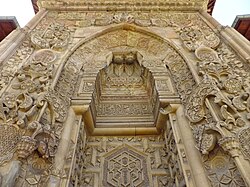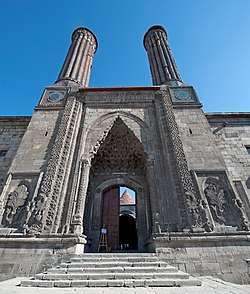From top to bottom: Tombs inside the Alâeddin Mosque in Konya (late 12th–early 13th century); Great Mosque of Divriği (1228–1229); Çifte Minareli Medrese in Erzurum (c. 1250) | |
| Years active | 11th–14th centuries |
|---|---|
| Location | Anatolia (present-day Turkey) |
Anatolian Seljuk architecture, or simply Seljuk architecture,[a] refers to building activity that took place under the Sultanate of Rum (late 11th to 13th centuries), ruled by an offshoot of the Seljuk dynasty that emerged from the Great Seljuk Empire (11th–12th centuries) alongside various other local dynasties. The Anatolian Seljuks patronized their own tradition of architecture whose surviving examples are generally found in present-day Turkey. Anatolian Seljuk architecture was eclectic and influenced by multiple traditions including Armenian, Byzantine, Iranian, and Syrian architecture. Unlike earlier Great Seljuk architecture to the east, their buildings were generally constructed in stone and featured significant stone-carved decoration as well as tile decoration. While the Seljuk Sultanate declined and ended in the late 13th century, architecture continued to flourish and diversify under the smaller Beylik states in Anatolia, which included the early Ottomans.
Cite error: There are <ref group=lower-alpha> tags or {{efn}} templates on this page, but the references will not show without a {{reflist|group=lower-alpha}} template or {{notelist}} template (see the help page).


